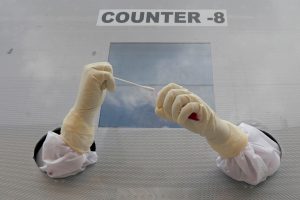July ended Friday as California’s worst month yet of the COVID-19 pandemic, with deaths hitting record after record and cases doubling to cross the half-million threshold — but there are signs that the spread of the virus has begun to slow down.
A total of 2,844 deaths were recorded in July, nearly 800 more than any month before it. Meanwhile, California counted 254,606 cases, surpassing the entirety of the pandemic before July. But growth appeared to be leveling off as the month came to a close, with test positivity and death rates decreasing, especially in prior hotspots like Southern California.
So where is California headed next?
“Overall, the data seem to indicate that we have perhaps reached a peak and are moving into a new plateau phase,” said Dr. George Lemp, an epidemiologist and former Director of the HIV/AIDS Research Program at the University of California, Office of the President. “We should continue to expect the impact of the surge for the next few weeks — but I’d expect that sometime later in August, we’ll begin to see the turndowns of hospitalizations and deaths.”
Over the past week, the state counted 5,000 fewer cases than the previous week — decreasing about 7%. The seven-day average number of new cases was at its lowest level in 11 days on Thursday, at 8,852 per day, while the seven-day average for testing positivity had fallen to about 7% for the first time since July 1. The World Health Organization recommends areas hit a positivity rate of 5% or lower before loosening lockdown restrictions.
In other words, the flood of cases that hit California in June and July — which epidemiologists say resulted from a hasty reopening, workplace outbreaks and impatient residents flouting social distancing practices — has finally begun to ebb.
Still, the state’s overall improvement conceals starkly divergent situations across regions, said Dr. Kirsten Bibbins-Domingo, professor and chair of the Department of Epidemiology and Biostatistics at University of California, San Francisco.
According to the California Department of Public Health, the 14-day average for test positivity rates have crept toward or past 20% in the hardest-hit Central Valley counties, while in the Bay Area, many counties remained below statewide levels. In Santa Clara County, the positivity rate is now at 3.3%, and it is even lower in San Francisco — 2.1%.
Los Angeles County, home to about a quarter of the state’s population and previously the pandemic’s epicenter, now has an average positivity of about 6.1% — lower than the state as a whole. And while the Southern California county still accounted for the largest share of COVID-19 deaths in July, it only saw a 13% increase in its death toll from 1,018 deaths in June.
Meanwhile, in the San Joaquin Valley, where cases per capita are rising at the fastest rate in the state, the number of deaths from COVID-19 more than tripled to 399 in July, from 118 in June.
“On average we’re doing better because Southern California is doing much better — but that’s happening when the Central Valley is doing much worse, and while other parts of the state, like the Bay Area, we’re watching closely,” Bibbins-Domingo said.
On Friday, the state counted the first death of a California child linked to COVID-19: A teenager in the Central Valley with underlying health conditions. More deaths and hospitalizations are likely in early August as early July’s surge in cases plays out, epidemiologists say.
“There’s no parts of the state where transmission is so low we can discard those strategies to mitigate spread,” Bibbins-Domingo added.
Other Bay Area public health officials seconded those warnings this week. San Francisco Department of Public Health Director Dr. Grant Colfax said Thursday that his county is in a “major surge” with a record 107 people hospitalized with the virus — up from just 26 patients about six weeks ago. If infection rates continue apace, Colfax predicts more than 750 San Franciscans hospitalized by mid-October.
“The unknown variable of all predictions is human behavior. Humans can do whatever they want to do given the facts,” said Dr. Peter Chin-Hong, professor of medicine and infectious disease expert at UCSF. “My prediction is we’ll have a dip again, and then we’ll reopen hopefully slower — but then we’ll have another surge.”
Evan Webeck contributed to this report.


















